�
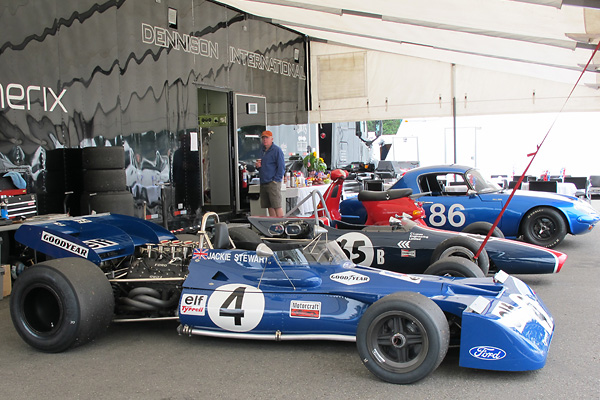
�
�
John Dimmer's 1971 Tyrrell Formula One Race Car
� � Owner: John Dimmer� City: Tacoma, Washington
� Chassis: Tyrrell 004
� Engine: Ford Cosworth DFV 3.0L V8
� Race prepared by: Butch Dennison �
�
How Tyrrell Racing Organisation Became a Constructor
��
Ken Tyrrell's driving career started at Goodwood in June 1952 when he contested the first�
heat of a Formula Three race in a second hand Cooper 500cc racecar. Although he loved racing - loved �
everything about the racing life - he soon began to realize that his driving skills would never�
match his aspirations. It occurred to Tyrrell that his greater talent might be in team management.�
In 1959, Ken Tyrrell signed Bruce McLaren to drive Formula Two cars. He set up a workshop and�
hired mechanics to provide the necessary infrastructure.�
�
Initially, Ken Tyrrell had no intention of building racecars from scratch. That idea came over a�
decade later. By 1969, Ken Tyrrell was managing the Matra International Formula One racing team.�
That was the year Tyrrell's superstar driver Jackie Stewart won six of eleven races to clinch his�
first Grand Prix championship. Matra had built a terrific chassis but didn't yet have a suitable�
engine of their own, so they used a Ford Cosworth DFV engine. For 1970, Matra was determined�
to field their own V12 engine. Neither Tyrrell nor Stewart believed the Matra engine could be�
competitive, so the team and the chassis builder parted ways. As a stop-gap measure, Ken Tyrrell�
purchased two March 701 chassis, but meanwhile things were quietly happening behind closed doors�
at the team's Ockham Surrey workshop. In August 1970, Tyrrell unveiled his team's "Secret Project"�
racecar. The following season, the Tyrrell Racing Organization dominated Formula One's Constructors�
Championship while scoring over twice as many championship points as their toughest rival. �
�
Please support the sponsoring companies who make www.BritishRaceCar.com possible, including:
� �
 �
�
�
�
�
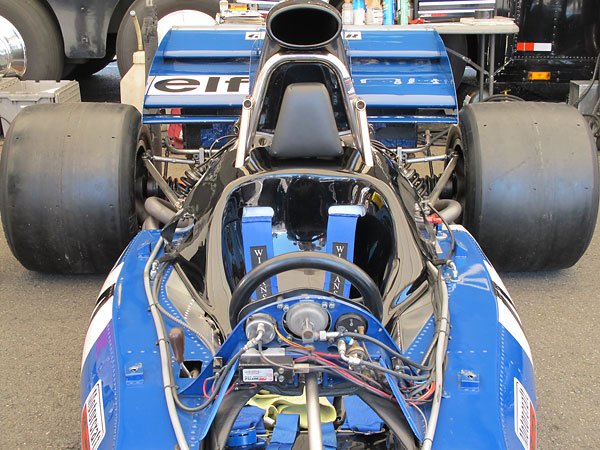
�
Derek Gardner designed an all-new aluminum monocoque tub for Tyrrell number 001. That first
�
racecar debuted in a non-championship Formula One race at Oulton Park on 22 August 1970.
�
Various modifications were made for cars 002 through 004. Whereas 001 had been optimized for
�
Jackie Stewart, the next three cars were made longer so that they could accommodate Francois
�
Cevert's height. According to Autocourse, the later cars were slightly narrower too.
�
Derek Gardner's Secret Project
��
Ken Tyrrell was always on the lookout for new talent, and he had a gift for finding and nurturing it.�
During the 1969 season, while running the Matra International Formula One team, Tyrrell had become�
familiar with Derek Gardner. Since 1961, Gardner had served as an engineer for Harry Ferguson Research,�
where he had specialized in transmission layouts for four-wheel-drive vehicles including racecars.¹�
Despite having no personal experience at racecar chassis or suspension design, Derek Gardner must have�
impressed Ken Tyrrell quite a lot. In February 1970 he was hired to develop an entirely new racecar�
for the Tyrrell team. According to Gardner, Tyrrell delivered the following challenge: "It is no good coming�
second. People forget about second. You must win." Furthermore, Tyrrell demanded complete secrecy for�
the project.�
�
Reviewing the project for an article in Motor magazine's 23 October 1971 edition, Gardner explained:�
"Ken's requirements were few but firm. The car had to be simple, competitive and�
there would be no time to develop it. It had to be right the first time. He impressed on me the need�
to have the car built on schedule. He said if it didn't race in the Gold Cup at Oulton Park (scheduled�
for 22 August 1970, less than seven months from the project's start!), the whole project would be scrapped.�
We might as well throw it in the Thames... It was necessary to prove to our driver and our sponsors that�
we would be competitive in 1971."�
�
Working from his home on Parklands Avenue in Leamington Spa, Derek Gardner assumed the cover of a�
private engineering consultant so he could procure prototype parts. Gradually, a mock-up racecar�
began to take shape in his personal garage, although in lieu of aluminum the prototype featured a�
wooden cockpit. Gardner labeled his engineering drawings with the project name "Esspe", derived�
from the designation "SP" for "Secret Project". The designation "001" wasn't used until months later. �
�
Gardner decided to focus on two technical priorities. First, the car should have an extremely low polar�
moment of inertia. In other words, components should be arranged to minimize the average distance of mass�
from the car's center of gravity. When everything else is equal, a car with a lower polar moment can�
change direction quicker while putting less demand on the tires. Secondly, Gardner believed the car's�
suspension should be extremely softly sprung in the interest of good road holding. Stiffly sprung cars�
tend to skate over road surface irregularities.�
�
Without any personal experience or training in aerodynamic design, the Tyrrell racecar's profile was�
a matter of guesswork. Gardner's initial intent was to create a sleek chisel-shaped profile. However,�
his decision to use a conventional nose-mounted radiator didn't facilitate a really low nose. His�
novel approach was to extend the flat top plane of the nose cone outward to create a rudimentary wing.�
(Tyrrell's distinctive "sports car nose" design came later. It debuted at the 1971 French Grand Prix.)�
Gardner's selection of a very short wheelbase and his focus on achieving a low polar moment of inertia�
complicated fuel packaging options; he decided that the most pragmatic solution was to give the car's�
monocoque tub a pot-belly shape. At the rear, a second element (i.e. a "flap") was specified for the wing.�
�
In our modern age, the design of a successful new Formula One car is a huge endeavor. Even if one�
designer gets top billing, we take for granted that a large team of experienced professionals worked�
feveriously behind the scenes. Derek Gardner's accomplishment: single-handedly designing a world-beating�
Formula One car, in just a couple months, on the drawing board in his family's spare bedroom, on his�
first try... It would have been a staggeringly amazing accomplishment in any era.�
�
At some point, drawings have to be turned over to machinists and fabricators. It might be instructive�
to consider that throughout the 1971 season The Tyrrell Racing Organisation was comprised of just 18�
employees. Six of the men who helped build the cars were also responsible for traveling to races and�
keeping them running. By any measure, Tyrrell was a small team. They were plucky underdogs. They worked�
well and hard together. And they were winners. �
�
 �
�
�
�
Tyrrell Number 004
��
The Tyrrell team was small, but they were capable of fielding two top-flight drivers throughout the Grand Prix�
season and of simultaneously developing a back-up driver. Thus, they needed at least three cars. Even when�
the back-up driver wasn't competing, the third car would travel to essentially every race for use in practice�
sessions (to save wear and tear on the front-line cars), for occasionally testing of new set-up and design�
ideas, and as a contingency - just in case one of the team's main racecars failed. Chassis number 004�
was the Tyrrell team's back-up car throughout 1972. �
�
Construction of chassis 004 was completed in October 1971, and it was sent to Kyalami in South Africa for�
testing in January 1972. The South African Grand Prix wasn't held until March, so there was lots of time�
for tuning and development. After South Africa, chassis 004 traveled with the team's other cars. Its best�
practice lap times at various circuits are noted below. �
�
Chassis 004's first actual Formula One Championship race appearance was at the 1972 Monaco Grand Prix.�
Heavy rain on Saturday continued through Sunday's race. Driving chassis number 004, Jackie Stewart�
spun once and also suffered an apparently rain-caused misfire throughout the final laps, yet he�
managed to hold on to a fourth place finish behind Jean-Pierre Beltoise (BRM), Jacky Ickx (Ferrari),�
and Emerson Fittipaldi (Lotus). �
�
Patrick Depailler drove Tyrrell 004 in the 1972 French Grand Prix, but suffered a tire puncture.�
�
In practice for the 1972 German Grand Prix, Francois Cevert drove 004 to a lap time of 7:28.5.�
On Friday he qualified even faster (7:12.2) in his primary car, but he subsequently inflicted�
heavy damage when he crashed at Pflanzgarten before the end of the session. Three suspension corners�
and the monocoque tub of Tyrrell 002 were damaged. However, because the team wished to retain�
his favorable qualifying time, they made a decision to repair 002 rather than simply press�
004 into service. Tyrrell 002 was stripped-down and its tub was straightened. The suspension�
and engine from 004 were then installed on 002 for the race. Cevert finished in tenth place. �
�
Patrick Depailler drove Tyrrell 004 in the 1972 United States Grand Prix at Watkins Glen. He�
qualified 11th fastest and finished in 7th place.�
�
�

�
TYRRELL - CHASSIS 004 - ANO 1971
�
Tyrrell 004's Formula One Results
�
Team Tyrrell 1972 Grand Prix Championship Results
�
| Race | Date | Jackie Stewart 003 / 005 | Francois Cevert 002 / 006 | Back-Up Car / Patrick Depailler 004 | |
| 1 | Argentine GP | Jan 23 | Q2 F1 | Q7 DNF | Not used. |
| 2 | S. African GP | Mar 4 | Q1 DNF | Q8 F9 | Stewart / practice only. Best lap: 1:18.2 |
| 3 | Spanish GP | May 1 | Q4 DNF | Q12 DNF | Stewart / practice only (1:19.71). |
| 4 | Monaco GP | May 14 | N/A | Q12 NC | Stewart qualified 8th (1:22.9), finished 4th. |
| 5 | Belgian GP | Jun 4 | (sick) | Q5 F2 | Stewart / practice only. (Time not recorded.) |
| 6 | French GP | Jul 2 | Q3 F1 | Q7 F4 | Depailler qualified 16th (2:59.6), NC (tire puncture). |
| 7 | British GP | Jul 15 | Q4 F2 | Q12 DNF | Not used. |
| 8 | German GP | Jul 30 | Q2 F11 | Q5 F10 | Suspension & engine shifted to 002 for race. |
| 9 | Austrian GP | Aug 13 | Q3 F7 | Q20 F9 | Not used. |
| 10 | Italian GP | Sept 10 | Q3 DNF | Q14 DNF | Stewart 1:36.75 / Cevert 1:39.50 in practice. |
| 11 | Canadian GP | Sept 24 | Q5 F1 | Q6 DNF | Stewart / practice only. (1:16.6) |
| 12 | U.S. GP | Oct 8 | Q1 F1 | Q4 F2 | Depailler qualified 11th (1:42.52), finished 7th. |
| Final: | 2nd | 6th | (Team finished 2nd in Constructors Cup.) |
�
Eddie Keizan drove Tyrrell 004 in Two FIA Grand Prix Championship Races
�| Race | Date | Qualified | Finished | |
| 1 | 1973 South African Grand Prix | March 3, 1973 | 22nd | 13th |
| 2 | 1974 South African Grand Prix | March 30, 1974 | 24nd | 14th |
�
Eddie Keizan drove Tyrrell 004 in Thirteen South African Series Formula One Races
�| Race | Date | Qualified | Finished | |
| 1 | Cape South Easter Trophy | January 6, 1973 | 2nd | 2nd |
| 2 | Highveld 100 | January 27, 1973 | 2nd | DNF (broken fuel line) |
| 3 | Goldfields Autumn Trophy | March 31, 1973 | 15th | 5th (shunt in final laps) |
| 4 | 1973 Mercury 100 | April 23, 1973 | 2nd | 2nd |
| 5 | South African Republic Festival Trophy | May 26, 1973 | 2nd | 2nd |
| 6 | Bulawayo 100 | June 10, 1973 | 2nd | 1st |
| 7 | Natal Winter Trophy | July 1, 1973 | 1st | DNF (broken oil line) |
| 8 | Rand Winter Trophy | August 4, 1973 | 2nd | 2nd |
| 9 | False Bay 100 | August 25, 1973 | 1st | 2nd (set fastest lap) |
| 10 | Rhodesian Grand Prix | September 23, 1973 | 2nd | 2nd |
| 11 | Rand Spring Trophy | October 6, 1973 | 2nd | 2nd |
| 12 | Goldfields 100 | October 20, 1973 | 2nd | DNF (broken throttle) |
| 13 | 1974 Mercury 100 | April 13, 1974 | 2nd | 4th |
�
Please support the sponsoring companies who make www.BritishRaceCar.com possible, including:
� �
 �
�
�
�
Provenance of John Dimmer's Tyrrell Racecar (chassis 004)
��
Tyrrell 004 was built in 1971 and retained through the 1972 FIA Formula One World Championship Season�
as a works racecar. It was driven in three races that season, once by Jackie Stewart and twice by Patrick Depailler.�
�
Alex Blignaut of South Africa purchased Tyrrell 004 in 1972. South African driver Eddie Keizan drove�
Tyrrell 004 in fifteen races. He achieved two victories plus six second-place finishes in the 1973 and�
1974 South African National Formula One Championship. He also competed in two FIA Formula One Championship�
races: the South African Grand Prix races of 1973 and 1974.�
�
Stephen Griswold of Berkeley, California purchased Tyrrell 004 in 1977, but is not known to have raced it.�
�
Robert D. Sutherland of Englewood, Colorado purchased Tyrrell 004 on March 1, 1978. He raced the car�
in select historic events until his death in 1999.�
�
John B. Dimmer of Tacoma, Washington purchased Tyrrell 004 at a Christie's International Motor Cars�
auction in Pebble Beach on August 20, 2000. Tyrrell 004 was carefully restored by Butch Dennison�
(who at that time worked for Pete Lovely Racing.) John Dimmer has enjoyed racing Tyrrell 004 at�
various vintage events since 2001.�
�
�
IMPORTANT ANNOUNCEMENT
�
BritishRaceCar.com will have to cut back plans for continued growth if we can't find more financial support.
�
If you like what you've found here, and you want to see more, please click here and follow the instructions.
�
Readers like you keep BritishRaceCar.com online and growing through voluntary financial contributions.
�
Features and Specifications (as currently presented)
�| Engine: | �Ford Cosworth DFV V8.�
(2993cc. 3.373" bore x 2.555" stroke. 11.0:1 static compression ratio. Rated 470 HP at 10,500 RPM.)�
Lucas mechanical fuel injection.�
Lucas OPUS (Oscillating Pick-Up System) electronic ignition system.�
Lucas Capacitor Discharge Ignition System. | �
| Cooling: | �front mounted radiator.�
Dual rear-mounted 25-row aluminum oil coolers. | �
| Exhaust: | �custom 4-into-1 headers. | �
| Transaxle: | �Hewland FG400 5-speed.�
CV-jointed halfshafts. | �
| Front Susp.: | �dual wishbone front suspension.�
Coilover KONI model 8212 double adjustable shock absorbers.�
Tyrrell magnesium front uprights.�
Adjustable (5-position) tubular anti-sway bar. | �
| Rear Susp.: | �single top links, parallel lower links, and twin radius arms.�
Tyrrell magnesium rear uprights (casting# L127).�
Coilover KONI model 8212 double adjustable shock absorbers.�
Adjustable (5-position) tubular anti-sway bar. | �
| Brakes: | �(master) dual Girling master cylinders with integral reservoirs. Adjustable bias bar. � (front) Girling calipers and outboard-mounted vented rotors. � (rear) Girling calipers and inboard-mounted solid rotors. | �
| Wheels/Tires: | �Tyrrell magnesium racing wheels.�
Avon racing tires (10.0/20.0/13 front by 15.0/26.0/13 rear). | �
| Instruments: | �(left to right)�
Racetech dual oil pressure (0-100psi) and oil temperature (40-140C) gauge,�
Smiths tachometer (0-12000rpm) without tattletale, and�
Smiths dual fuel pressure (0-160psi) and water temperature (30-120C) gauge. | �
| Safety Eqmt: | �Willans six-point cam-lock safety harness.�
Strange Engineering quick release steering wheel hub.�
FireBottle centralized fire suppression system. | �
| Dimensions: | �overall length = 152.0", wheelbase = 95.7", front track = 63.0",�
rear track = 64.9", weight = 1224 pounds. | �
Engine Installation
��
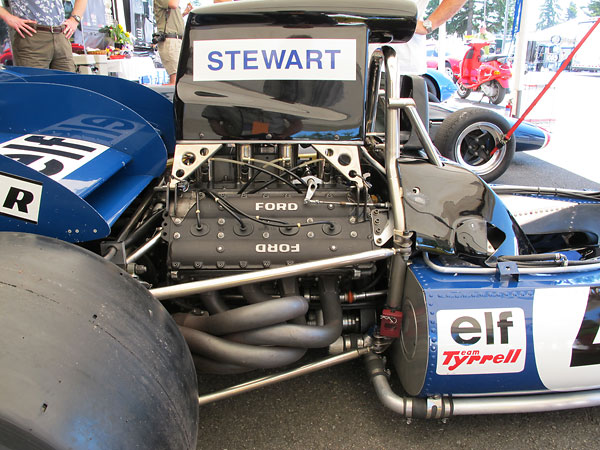
�
Ford Cosworth DFV V8: 2993cc, 3.373" bore x 2.555" stroke, 11.0:1 static compression.
�
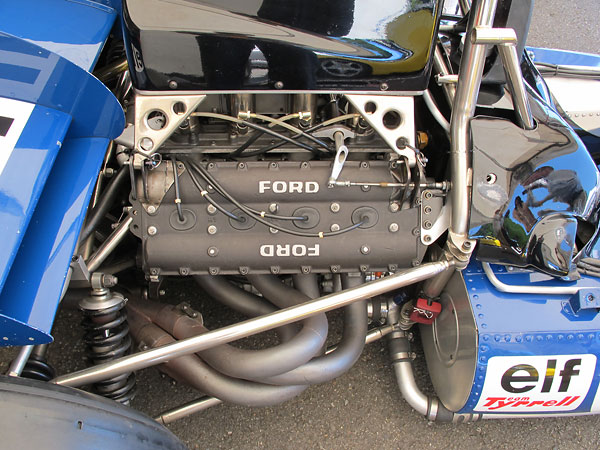
�
Cosworth DFV engines delivered twelve World Championships in sixteen seasons, from 1968 and 1983.
�
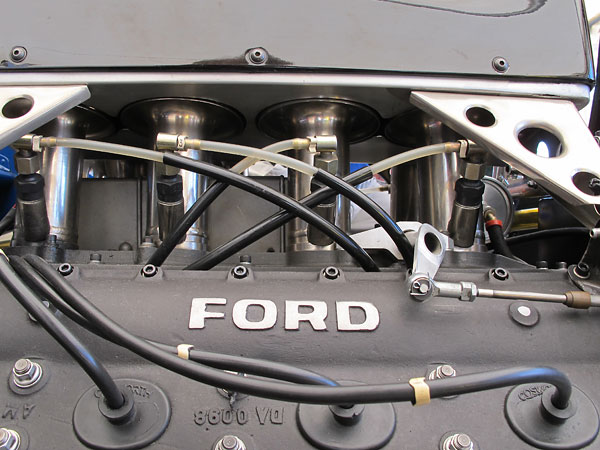
�
Lucas mechanical fuel injection.
�
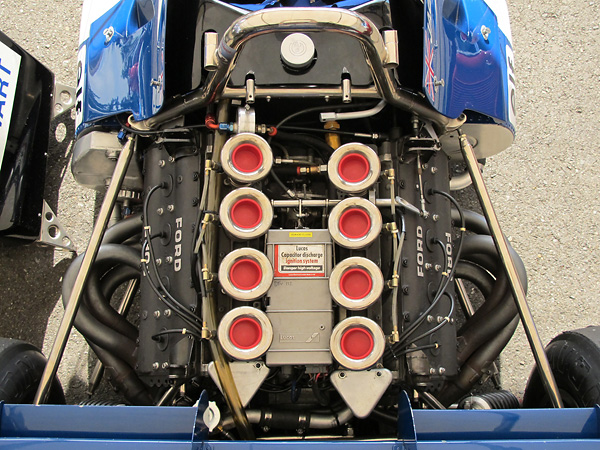
�
Eighteen of twenty-one teams contesting the 1971 Grand Prix championship chose Cosworth DFV engines.
�
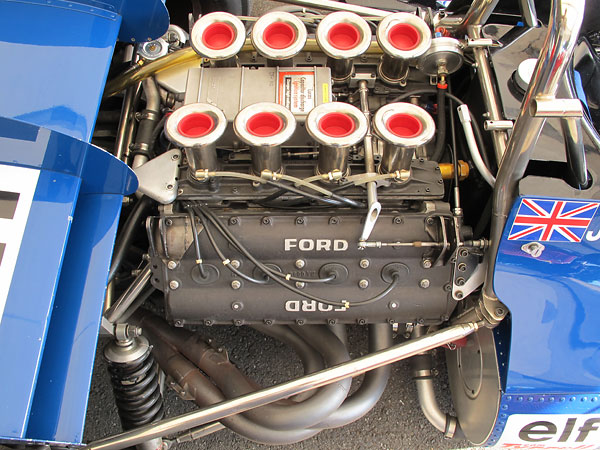
�
Did Tyrrell or Stewart have an unfair advantage? Claims of that came up regularly because Stewart's
�
DFV-powered racecar seemed to pull stronger than other DFV cars. One advantage might have been
�
new lubricant technologies Team Tyrrell had through their partnership with ELF. They were certainly
�
given special lubricants for testing. ELF was the first company to produce synthetic oils for racing.
�

�
Lucas Capacitor Discharge Ignition System - Danger High Voltage. Various versions of this system
�
were produced for the Ford Cosworth DFV V8 engine over the years. By the housing and its sticker
�
we can tell that this particular ignition box was produced later in the 1970s.
�
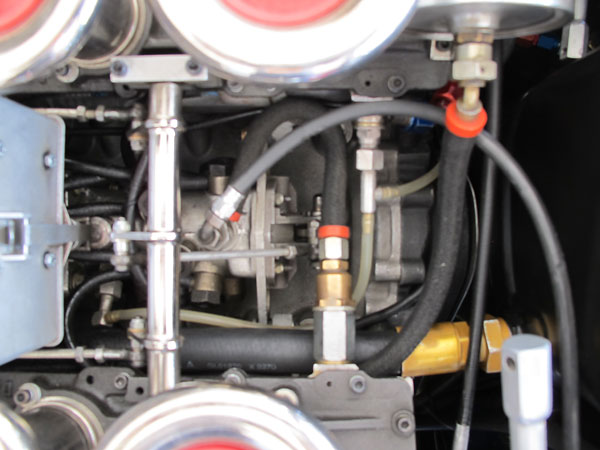
�
Lucas Mk1 mechanical fuel injection metering unit, gear driven off the crankshaft.
�

�
Throttle cable and linkage fabrication details.
�

�
The second of two centrifugal water pumps.
�

�
Scavenge oil pump draws oil from the shallow dry sump oil pan.
�

�
Beautifully crafted custom 4-into-1 headers. In June 1971, Cosworth determined that shortening the
�
length of the exhaust primary pipes from 30.5" down to 25.5" but leaving the tail pipe 27" long would
�
typically add at least 20 horsepower at tuned engine speed, to reach a claimed 470 HP at 10,500
�
RPM. New headers were installed on Jackie Stewart's racecar in time for the French Grand Prix at
�
the Paul Ricard circuit on July 4th. Race results show that Stewart was substantially quicker than
�
any other Cosworth driver, and to his delight he could now out-run Ferraris on the mile-long straight.
�
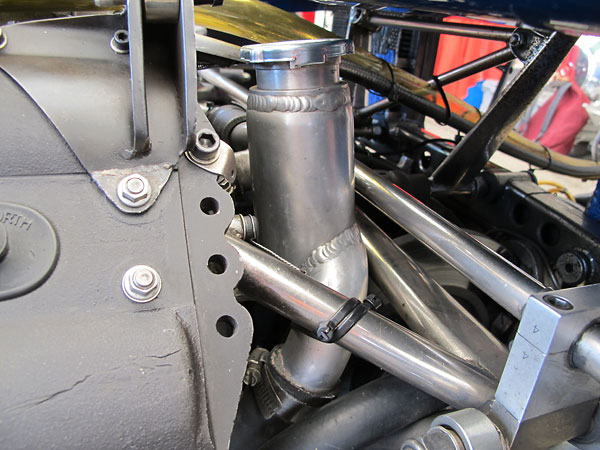
�
Custom fabricated coolant swirl pot.
�
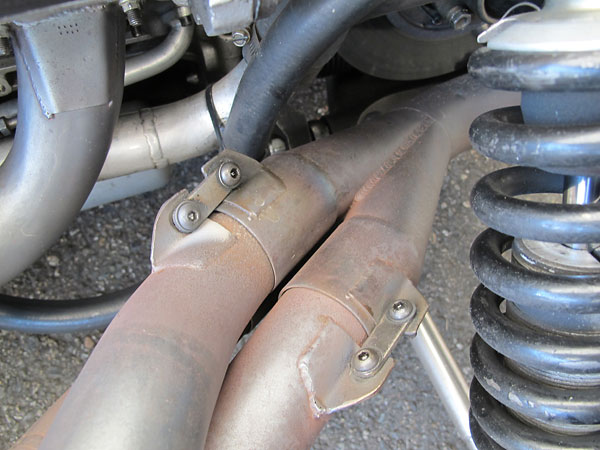
�
Exhaust header slip joints.
�
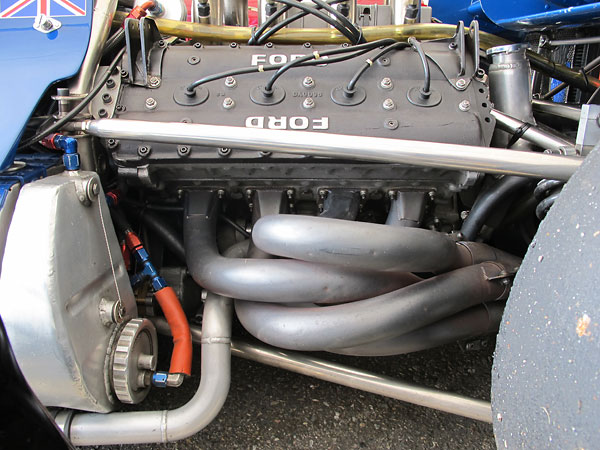
�
The engine oil reservoir is tucked away out-of-sight, ahead of the engine.
�
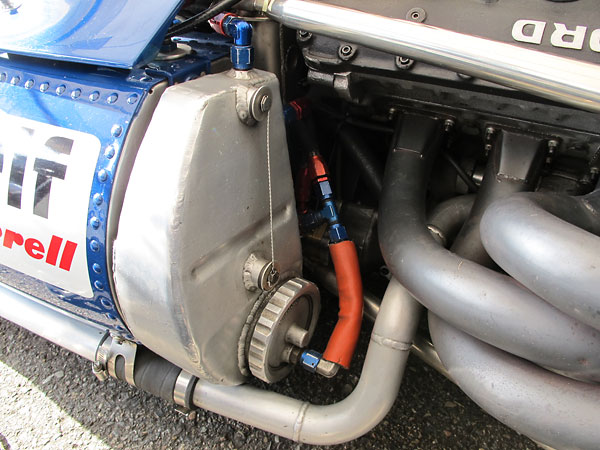
�
The Tyrrell racecars feature two conventional fuel cells, to the left and right of the cockpit. This
�
photo shows a small additional fuel "make-up tank". A low pressure electric fuel pump transfers fuel
�
into this tank. The high pressure pumps that supply the fuel injectors draw their supply from here.
�
�
Front Suspension
��
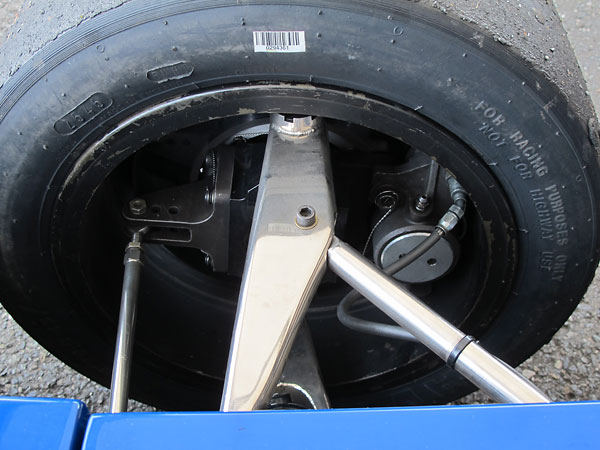
�
Derek Gardner designed custom magnesium uprights for the Tyrrell racecars, and they were built
�
by Jack Knight Developments. During Tyrrell 001's debut at the 1970 Canadian Grand Prix, after
�
qualifying fastest and leading the race, Jackie Steward broke a stub axle. (He had completed
�
31 of 90 laps.) Derek Gardner rushed back to England, redesigned the front uprights, had two
�
new uprights made, and he flew back across the pond in time for Watkins Glen two weeks later.
�

�
After that redesign of the front uprights, the balance of Gardner's front suspension proved robust.
�
It was also simple and it was easy to set-up. This was at a time when other Formula One
�
designers were experimenting with rising rate front suspension designs.
�
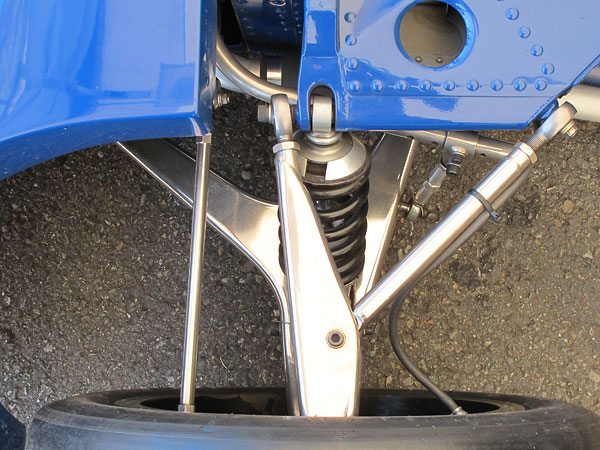
�
The forward members of the wide-based one-piece lower control arms are supported by the
�
tubular steel subframe which carries the radiator.
�
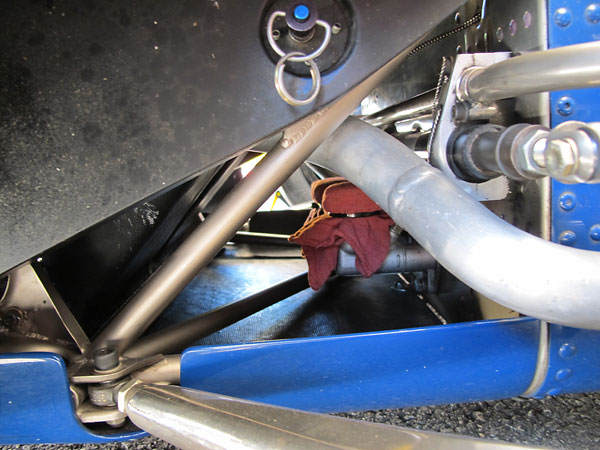
�
Dual Girling master cylinders with integral reservoirs.
�
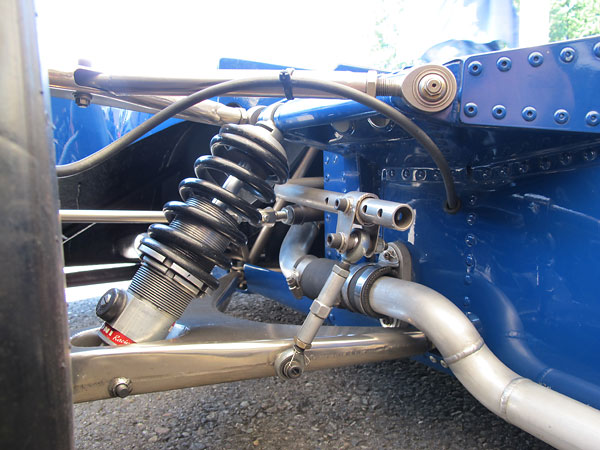
�
KONI 8212 double adjustable coilover shock absorbers. Adjustable (5-position) tubular anti-sway bar.
�
�
Enjoying this article? www.BritishRaceCar.com is partially funded through generous support from readers like you!
�
To contribute to our operating budget, please click here and follow the instructions.
�
(Suggested contribution is twenty bucks per year. Feel free to give more!)�
Rear Suspension
��
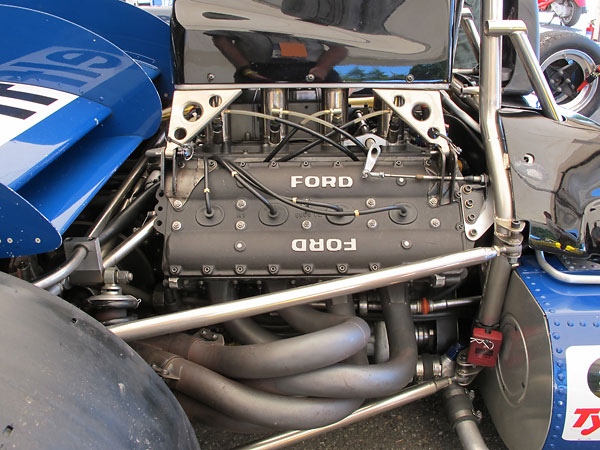
�
Rear suspension: single top links, parallel lower links, and twin trailing radius arms.
�
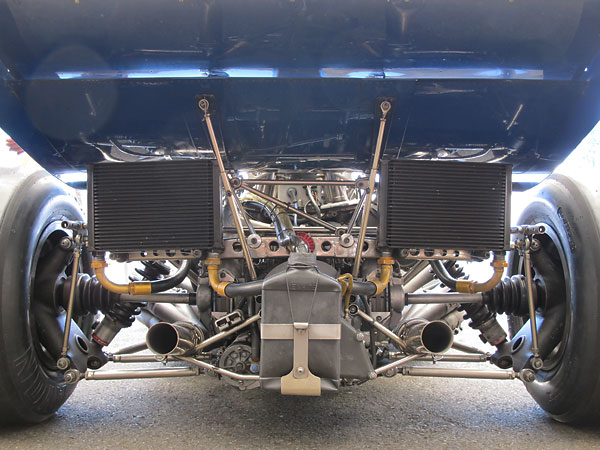
�
Dual 25-row oil coolers disturb and reduce airflow under the rear wing.
�

�
Elaborate wing support structure.
�

�
Derek Gardner specified variable coil pitch springs for the rear suspension of the Tyrrell racecars.
�
As variable pitch springs compress they progressively bind-up and wheel rate increases accordingly.
�
Now, in vintage racing trim, Tyrrell 004 is no longer fitted with a rising rate suspension.
�

�
The central shaft of this starter extends out the back of its housing to facilitate mechanical jump starting.
�
The more familiar plastic plug above the starter motor is for regular electrical jump starts.
�
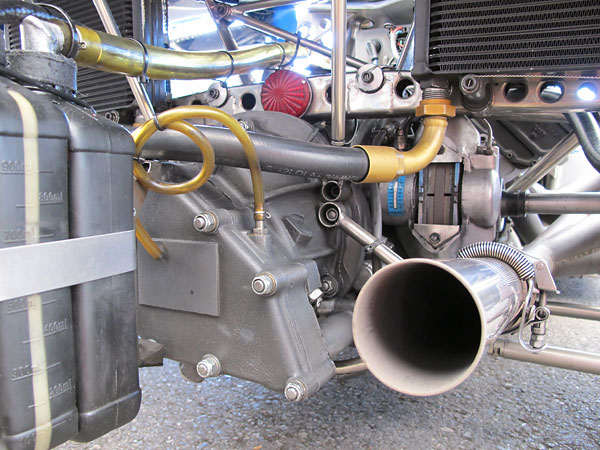
�
The Hewland FG400 5-speed transaxle worked reliably and was economical, but Derek Gardner complained
�
about its weight: 112 pounds. Furthermore, he estimated that heat and pump losses came to at least 10bhp.
�

�
Girling brake calipers and inboard-mounted solid rotors.
�
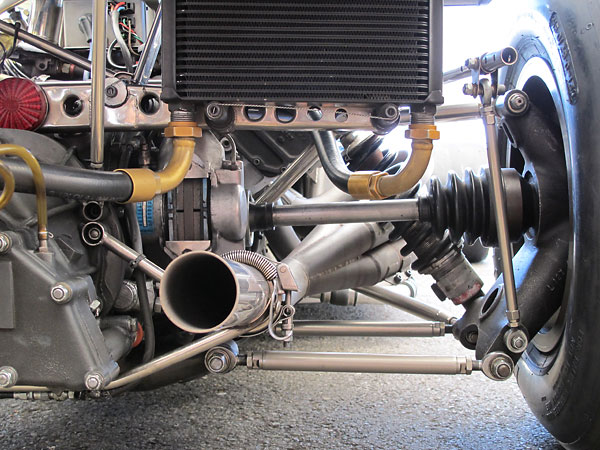
�
Tyrrell magnesium rear uprights (casting# L127).
�
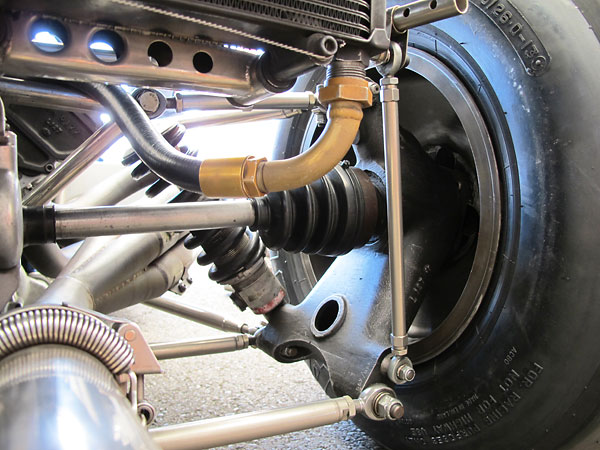
�
CV-jointed halfshafts.
�

�
Two alternate rear suspension pick-up points.
�
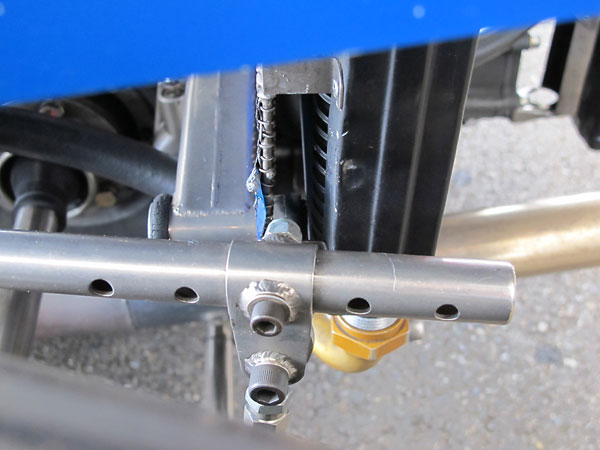
�
Adjustable (5-position) tubular anti-sway bar.
�
�
Interior
��
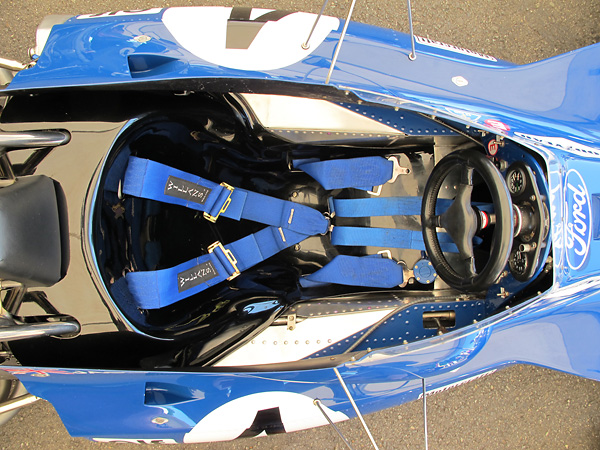
�
Willans six-point cam-lock safety harness.
�
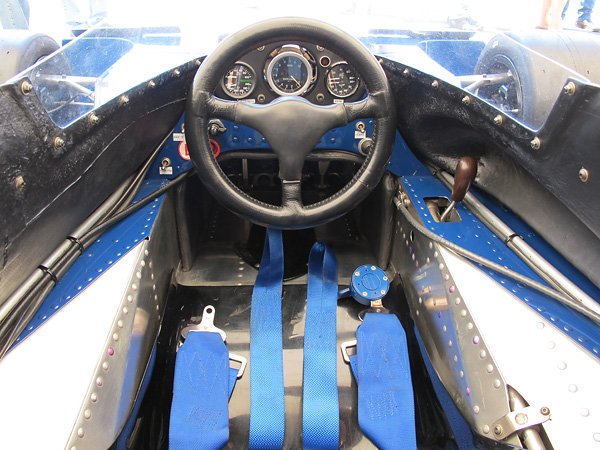
�
Jackie Stewart's business office, circa 1971.
�
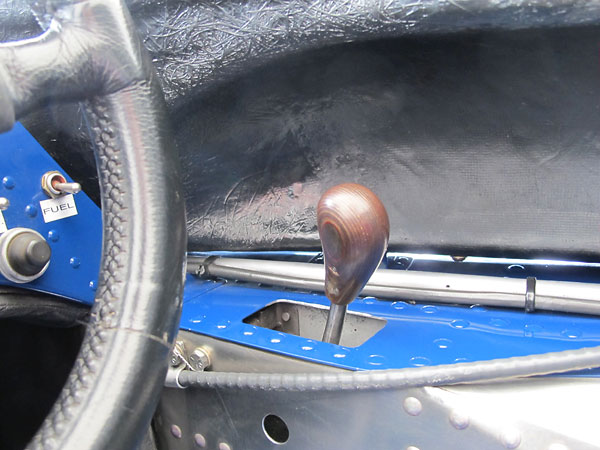
�
Gear shifter knob.
�

�
Fiberglass seat insert.
�
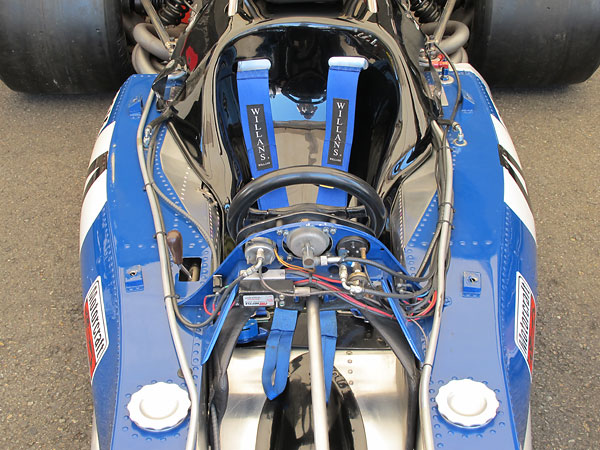
�
Instrument panel construction details.
�
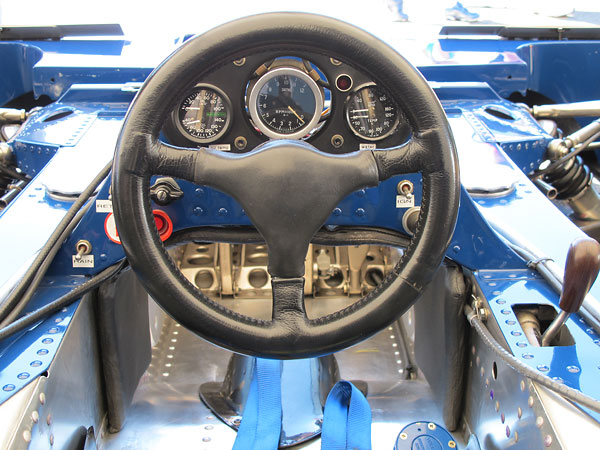
�
Racetech dual oil pressure & oil temperature gauge, Smiths tachometer, and Smiths
�
dual fuel pressure & water temperature gauge.
�
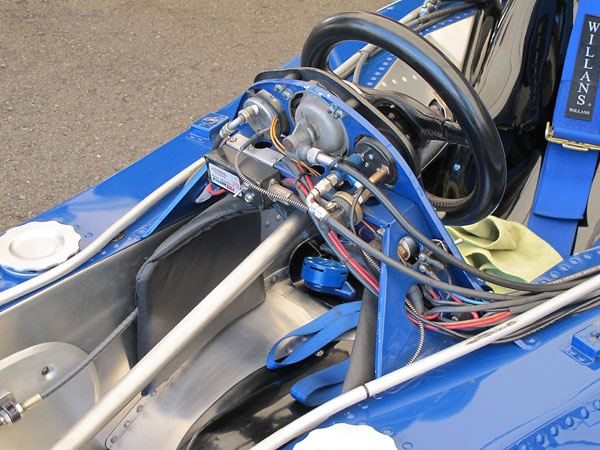
�
Control module for a FireBottle fire suppression system, on the back of the instrument panel.
�
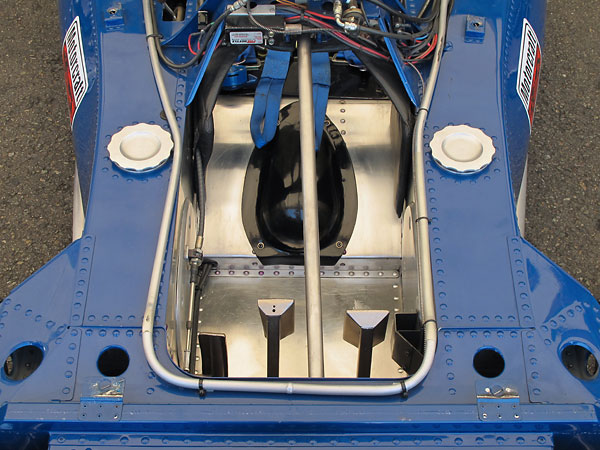
�
The fire suppression system's pressure bottle is mounted between and below the driver's knees.
�
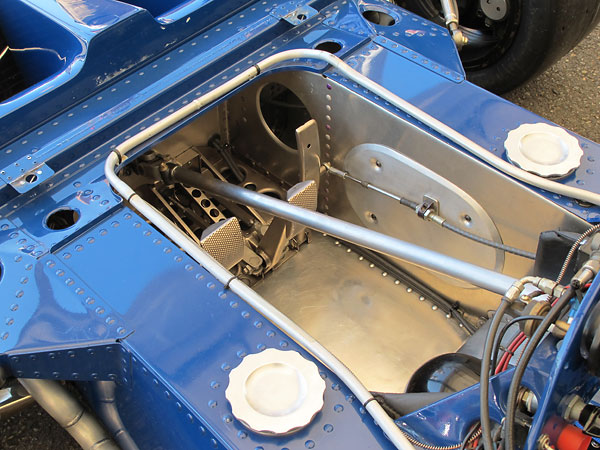
�
Tyrrell racecars are known for meticulous fabrication and preparation. However, few close-up photos of
�
the cars appeared in period publications. (That's one reason it's difficult to analyze their design now.)
�
Since Tyrrell never produced cars for outside customers, there was no need to divulge technical details
�
to the public. Cut-away drawings of racecars were popular in period magazines, but when Tyrrell racecars
�
were shown in cut-away view they tended to contain less detail than illustrations of rival racecars.
�
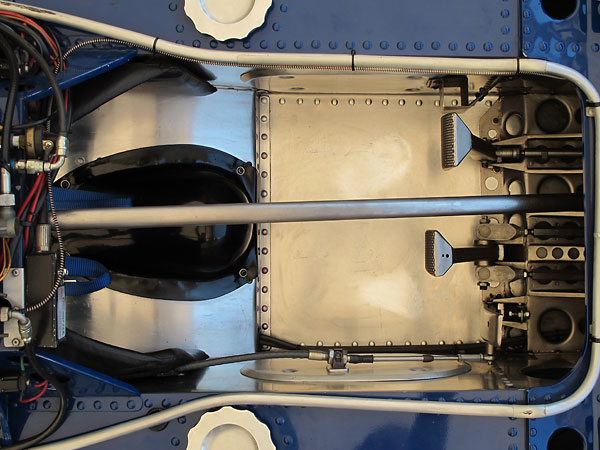
�
Very few outside suppliers saw the inside of Tyrrell's shop or knew what was being planned. As designer
�
Derek Gardner later told author Christopher Hilton: "In those days we operated a very simple principle,
�
and it's still the most reliable: if you don't want people to know, you don't tell them!" This approach
�
allowed Tyrrell to design and build 001 in secret. Even more surprisingly, it allowed Tyrrell to develop the
�
famous P34 six-wheeled F1 racecar for the 1976 season without a single rumour to spoil its unveiling.
�

�
Tyrrell 004 suffered just one minor shunt in its original racing career, so it was a particularly good
�
candidate for restoration. Almost all of the sheetmetal tub's panels are original, although its
�
been taken apart and reassembled.
�

�
Simple, serviceable pedal assemblies.
�
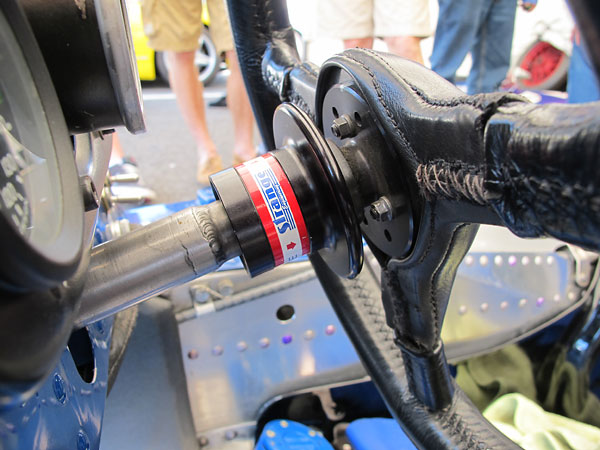
�
Strange Engineering quick release steering wheel hub.
�
�
Exterior
��
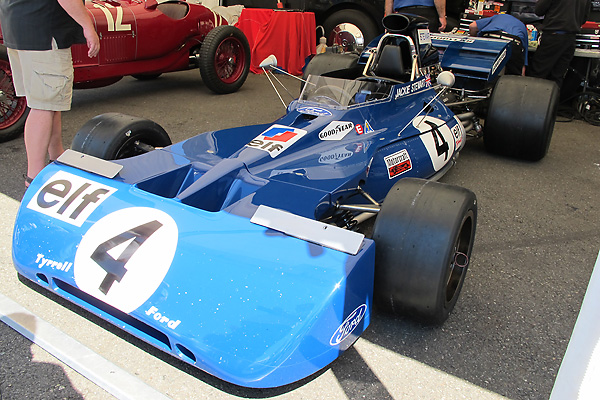
�
During SOVREN's 2011 Pacific Northwest Historics at Pacific Raceways in Kent Washington,
�
John Dimmer circled the beautiful 2.25 mile circuit with a best lap time of 1:23.424, which
�
averages out to 97.09mph.
�

�
While the Gold Leaf Team was storming through the 1970 Formula One season with the new Lotus 72 -
�
Jochen Rindt won four in a row at mid season - Team Tyrrell was finishing up construction of their own
�
chassis. The two new models were strikingly different. The Lotus 72 featured inboard-mounted shocks
�
absorbers, torsion bar springs and front brakes. A chisel nose and dual side-pod mounted radiators
�
were also part of a streamlining program. The 72 was produced in number and persisted over years.
�

�
After a brief trial of placing wings to either side of a single front-mounted radiator, Tyrrell
�
switched to a sports car nose. This was a pragmatic design decision; the nose broke wind for
�
outboard mounted suspension and brake components while also serving as a partial fairing for
�
the tires. This paid off in 1971, when Jackie Stewart won the Formula One championship.
�

�
For the 1970 season, the Tyrrell Racing Organization had partnered with the Dunlop tire company.
�
When Dunlop exited F1, Tyrrell switched to Goodyear tires. A close and highly effective working
�
relationship with Goodyear's engineers gave Tyrrell a competitive edge. Meanwhile, Goodyear
�
gathered steam. In 1973, all Formula One championship race winners raced on Goodyear tires.
�
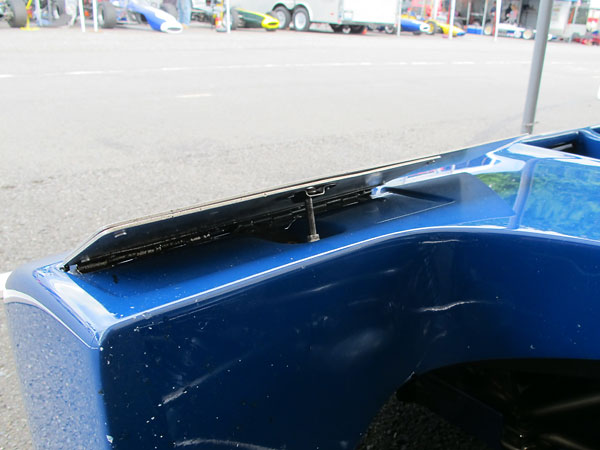
�
Adjustable aerodynamic flaps on the Tyrrell sports car style nose.
�
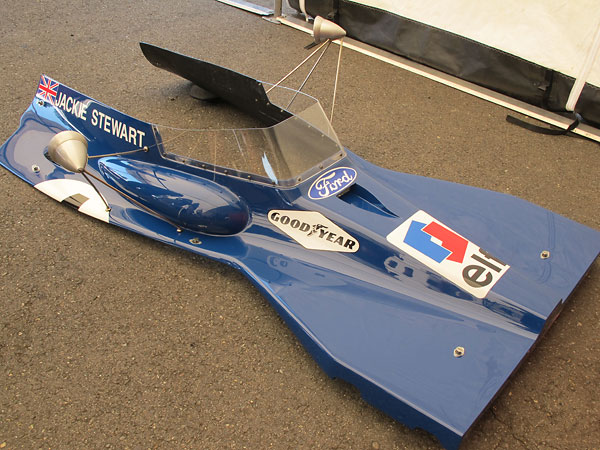
�
Tyrrell fabricated all their own fiberglass body parts, which helped the team maintain
�
secrecy throughout the development and evolution of their racecars designs. The
�
fiberglass panels are held down by spring-loaded Dzus quarter-turn fasteners.
�

�
Derek Gardner originally conceived a flat-sided monocoque tub. Bulged sides were an afterthought,
�
which came about when he realized the car would need an additional ten gallons of fuel capacity.
�
The Ralph Bellamy designed McLaren M19 featured similarly shaped fuel packaging throughout
�
1971 and 1972. New safety rules would make this style of fuel cell packaging obsolete in 1973.
�
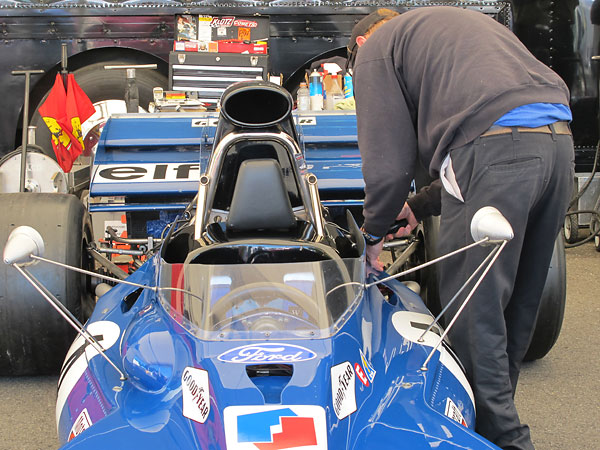
�
Mirrors are mounted outboard for a view around the oil coolers. (Lotus 72 mirrors are close-coupled
�
despite a similar rear wing installation, because Lotus mounted their oil coolers elsewhere.)
�
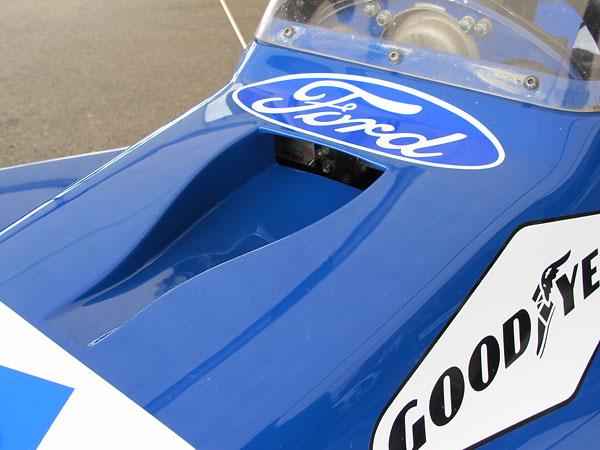
�
Three vents in the bodywork provide cool, fresh air to the driver. The two on the sides of the
�
body are NACA ducts, although not ideally formed or situated. This one is styled to look like
�
a NACA duct too, but it operates by a different principle. The steep, flat windscreen produces
�
a high pressure area, so any hole through the bodywork here would allow pressurized air to
�
flow into the cockpit. NACA ducts extract air from of an otherwise smoothly laminar airstream.
�
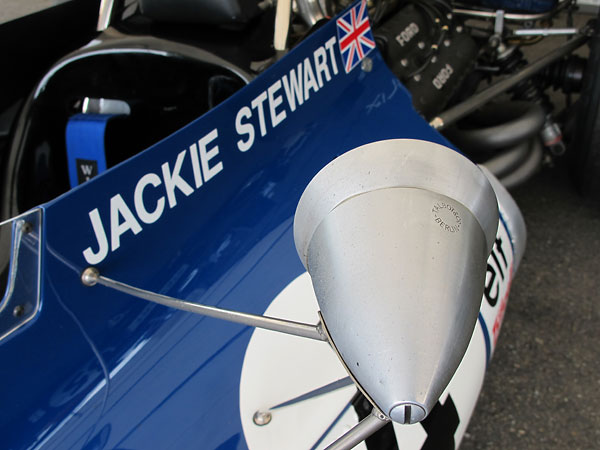
�
Jackie Stewart drove this Tyrrell racecar in the 1972 Monaco Grand Prix. It also served as
�
Stewart's practice and back-up car for at least four other races during the season.
�

�
Talbot & Co., Berlin side view mirror.
�

�
Next to Jackie Stewart's name we see the union flag of Great Britain, which frankly is a big surprise.
�
Tyrrell chassis number 003 undoubtedly displayed the blue-and-white Saint Andrew's cross flag of
�
Stewart's native Scotland. In fact, the Scottish flag still appears on 003 today. Car 003 is owned
�
by Jackie Stewart and it's on display at the The National Museum of Scotland in Edinburgh.
�

�
ELF Team Tyrrell decal. "Essence et Lubrifiants de France" was France's state-owned gasoline and
�
oil company, which enthusiastically sponsored French racing teams and drivers in the highest levels
�
of international motorsport. ELF's association with Ken Tyrrell and Jackie Stewart started while
�
those two gentlemen were involved with the Matra Formula One race team.
�

�
Adjustable, padded headrest assembly.
�
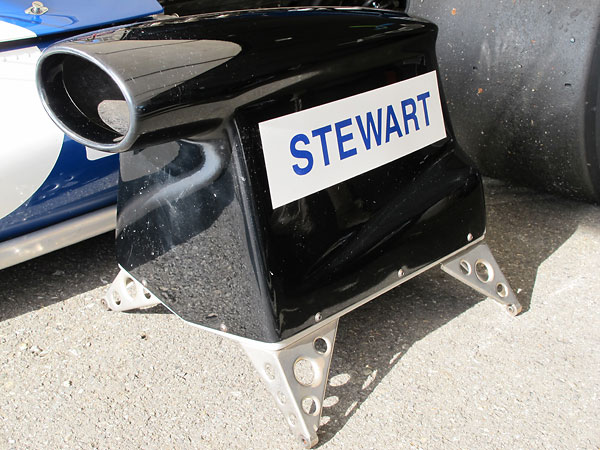
�
A high-mounted airbox serves at least four important functions: (1) provides smooth (i.e. non-turbulant)
�
and evenly distributed airflow to the engine's various induction stacks, (2) provides some ram-air
�
effect at high vehicle speeds, (3) draws induction air from higher off the track surface, where air
�
is generally cooler and therefore denser, and importantly (4) smooths airflow to the rear wing.
�
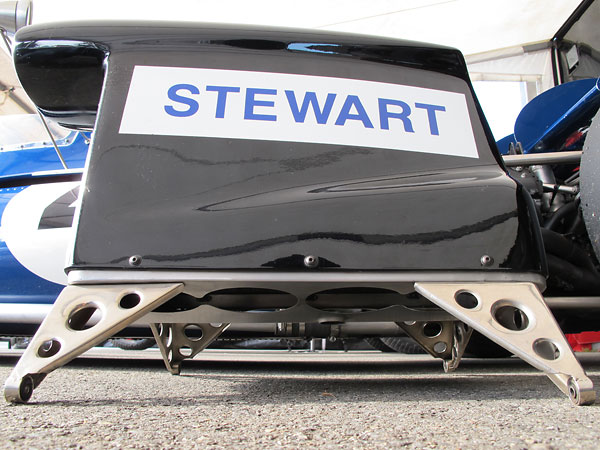
�
Use of high-mounted airboxes on Formula One racecars was pioneered by the innovative Lotus 72 model
�
which was developed for the 1970 season. By 1971, most of the Formula One field were using airboxes
�
too although efficacy varied widely. For most teams development was a matter of trial and error,
�
with lap times and driver feel their only measures of design success. Some teams experimented
�
with new designs in practice, then chose to run without airbox in the actual race.
�

�
Various sources, including principally Autocourse, have cited the airboxes used on Jackie Stewart's
�
Tyrrell 003 and 004 racecars as a significant performance advantage. Of course, it's impossible to
�
quantify one factor among so many. Stewart won six of eleven championship races in 1971. The
�
Tyrrell team wasn't motivated to tinker with airbox design while rivals played catch up.
�

�
Formula One rules have at times been reactionary. After high-mounted rear wings caused two scary
�
accidents in practice for the 1969 Monaco Grand Prix, the FIA put tough restrictions on wing design.
�
One critical rule: the highest point on the wing could be no higher than 31.2" (80cm) above the
�
lowest point on the chassis. Gardner's use of a (basically) three element wing was innovative.
�
However, mounted higher and further back it could have been so very much more effective.
�

�
Team Tyrrell brought a new and improved racecar to the 1972 French Grand Prix at the beginning of
�
July. Designated 005, its performance in practice sessions was dissappointing so it was held back.
�
However, once it was sorted Tyrrell 005 performed spectacularly. Jackie Stewart drove Tyrrell 005
�
to easy victory at Mosport, and Team Tyrrell finished one-two at Watkins Glen. Jackie Stewart
�
qualified fastest and drove the race's quickest lap. It was a taste of things to come in 1973.
�
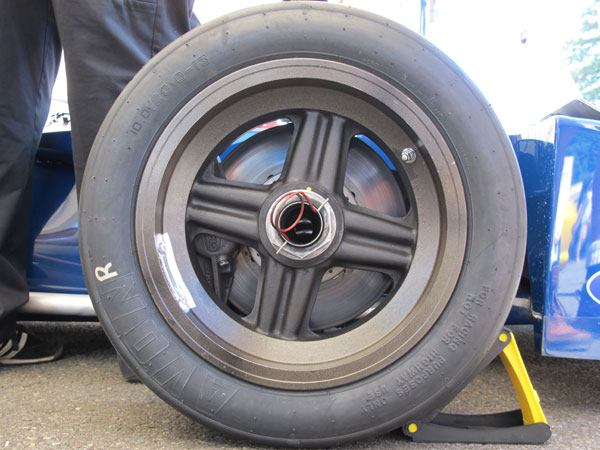
�
Tyrrell magnesium racing wheels.
�

�
Avon racing tires (10.0/20.0/13 front by 15.0/26.0/13 rear).
�
| Notes: | ||
| (1) | �
In the late sixties, many people believed four-wheel-drive (FWD) would become a dominant technology�
in Formula One racing. Four different constructors developed and tested FWD cars during the 1969�
season. Derek Gardner worked on Matra's MS84 model; it was driven in five Formula One races but was�
never remotely competitive. In 1971, Lotus updated their type 56 4WD turbine-powered Indy 500 car�
to Formula One specs and entered it in several races, but it was also uncompetitive. In the context of�
rapid development of aerodynamic and tire compounding technologies 4WD was found to be uneconomical,�
heavy, and complex. 4WD has been banned in Formula One since 1982. �
� | |
�
| �
�  � (Brian Redman's Lola T332, as photographed by Curtis Jacobson for BritishRacecar.com) � Did you enjoy this article? We currently have eighty more in process, featuring about 6000 new photos. � But it takes a lot of time and expense to turn photos into articles, and to publish them on the internet. � Please consider making a contribution. Your donation will help us publish more and better articles! � � |
�
�
Unless otherwise noted, all photos shown here are from June 2011 when we viewed Tyrrell 004 at�
The Pacific Northwest Historics at Pacific Raceways in Kent, Washington.�
All photos by Curtis Jacobson for BritishRaceCar.com,�
copyright 2011. All rights reserved.
�
| If you liked this article, you'll probably also enjoy these: | �|||||
 | �
Kurt DelBene 1962 BRP-BRM | �
 | �
Mead Korwin 1971 Lola T192 | �
 | �
Phil Mauger 1973 McLaren M23 | �
| You're invited to discuss anything you've seen here on The British Racecar Motorsports Forum! | �|||||
�
Notice: all the articles and almost all the photos on BritishRacecar.com are by Curtis Jacobson.
�
(Photos that aren't by Curtis are explicitly credited.) Reproduction without prior written permission is prohibited.
�
Contact us to purchase images or reproduction permission. Higher resolution images are optionally available.
�

 �
�